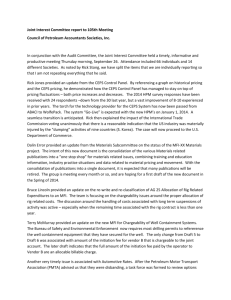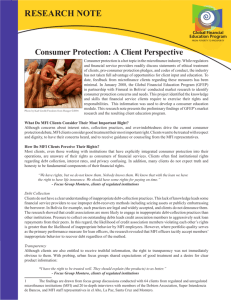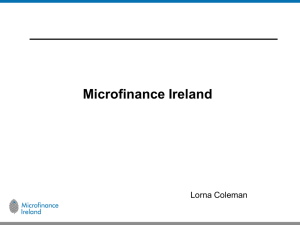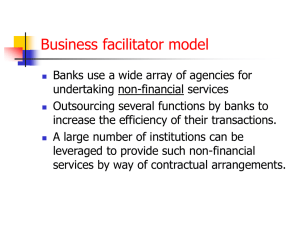Pursuant to Article 35 of the Law No. 03/L
advertisement
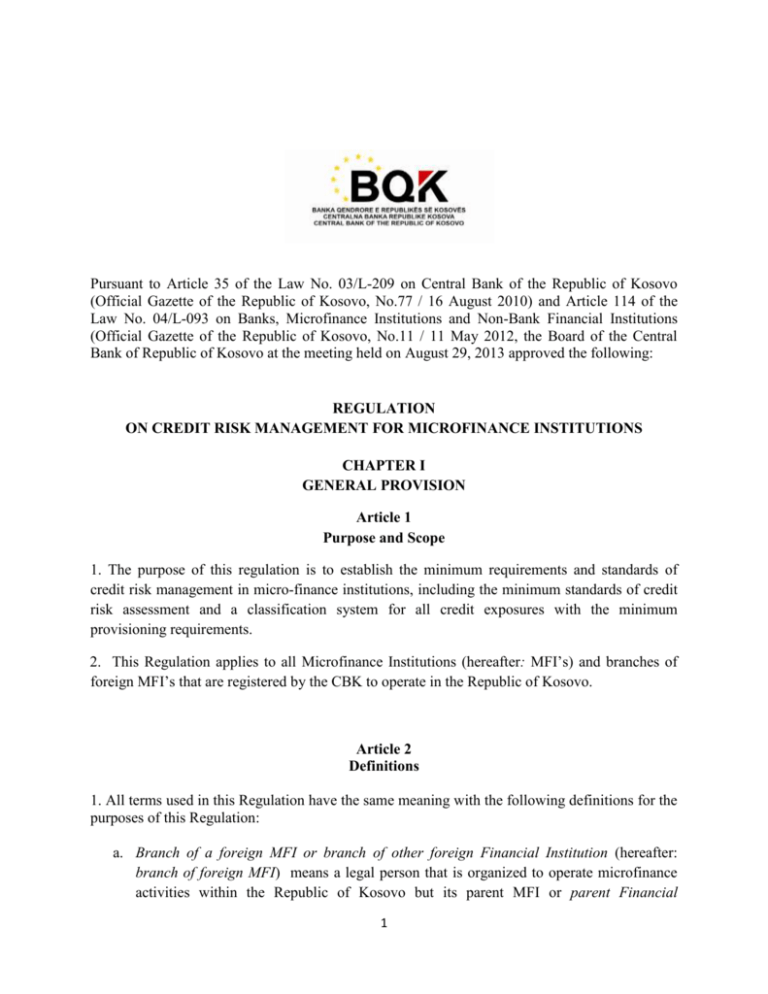
Pursuant to Article 35 of the Law No. 03/L-209 on Central Bank of the Republic of Kosovo (Official Gazette of the Republic of Kosovo, No.77 / 16 August 2010) and Article 114 of the Law No. 04/L-093 on Banks, Microfinance Institutions and Non-Bank Financial Institutions (Official Gazette of the Republic of Kosovo, No.11 / 11 May 2012, the Board of the Central Bank of Republic of Kosovo at the meeting held on August 29, 2013 approved the following: REGULATION ON CREDIT RISK MANAGEMENT FOR MICROFINANCE INSTITUTIONS CHAPTER I GENERAL PROVISION Article 1 Purpose and Scope 1. The purpose of this regulation is to establish the minimum requirements and standards of credit risk management in micro-finance institutions, including the minimum standards of credit risk assessment and a classification system for all credit exposures with the minimum provisioning requirements. 2. This Regulation applies to all Microfinance Institutions (hereafter: MFI’s) and branches of foreign MFI’s that are registered by the CBK to operate in the Republic of Kosovo. Article 2 Definitions 1. All terms used in this Regulation have the same meaning with the following definitions for the purposes of this Regulation: a. Branch of a foreign MFI or branch of other foreign Financial Institution (hereafter: branch of foreign MFI) means a legal person that is organized to operate microfinance activities within the Republic of Kosovo but its parent MFI or parent Financial 1 Institution has its head office and holds a license to engage in the activities of microfinance in a jurisdiction other than the Republic of Kosovo; b. Past due loans - are defined as the loans classified in the categories of credit classification as: watch, substandard, doubtful and loss; c. Classified loans - are defined as the loans classified in the categories of credit classification as: substandard, doubtful and loss; d. Non-performing loans - defined as the loans classified in the categories of credit classification as: doubtful and loss; e. Rescheduled loans - are defined as loans that have been restructured and re-negotiated between MFI and borrowers because of a deterioration in the financial position of the borrower or of the inability of the borrower to meet the original repayment schedule; f. Delinquent interest - is defined as interest which is not paid before the loan is being rescheduled; g. Fair market value - is the price at which an asset would sell for in the open, free market, with willingness of buyer and seller, and no pressure is applied to either; h. Sustained performance - is defined as at least four contractual payments of principal and interest; i. Split Classifications - means that a portion of the exposure is adequately protected or better protected than other portions; j. Director – means any person appointed by the shareholders/founders to serve as a member of a MFI’s Board of Directors and approved by the CBK; k. Senior Manager - means the chief executive officer, chief financial officer, chief operating officer and chief risk officer of a MFI and any person, other than a director, who (i) reports directly to the board or participates or has authority to participate in major policymaking functions of the MFI, whether or not such person has an official title or receives compensation for such actions, and (ii) is designated as a senior manager by the CBK. In the case of a foreign MFI registered to operate one or more branches in Kosovo, the manager of the principal branch in Kosovo will be deemed to be a member of senior management; l. MFI- Related Person – means any person that maintains with the MFI at least one of the following relationships: 2 i. any Senior Manager or Director of the MFI and any principal shareholder or founder of the MFI; ii. any person who is related to a Senior Manager or Director or principal shareholder or founder of the MFI by marriage or consanguinity to the second degree; iii. any legal entity in which a Senior Manager or Director or principal shareholder or founder of the MFI is also a principal shareholder; iv. any person that has a significant interest in a legal entity in which the MFI has a significant interest. CHAPTER II GENERAL REQUIREMENTS ON CREDIT RISK MANAGEMENT Article 3 Credit Risk Management System 1. MFI’s should have in place a system for credit risk management, adequate to the nature, volume and complexity of the MFI’s activities. 2. Credit risk management system shall consist of the strategy, policies, procedures, rules and MFI’s structures used to manage the credit risk. 3. Credit risk management system should provide the ongoing assessment of credits and other assets’ quality on a timely basis, including determining the adequacy of reserves to cover losses related to this risk. Article 4 Strategies and Policies 1. MFI’s should develop the strategy and policy to manage their credit risk. The credit risk strategy and policies should be effectively communicated throughout the institutions. All relevant personnel should clearly understand the MFI’s approach to granting and managing credit and should be held accountable for complying with established policies and procedures. 2. The very basic purpose of a credit risk strategy is to determine the risk appetite of the MFI’s. Once it is determined, the MFI’s should develop a plan to optimize return while keeping credit risk within predetermined limits. Credit risk strategy shall minimally consist of: a. Statement of the MFI’s willingness to grant credit based on various client segments and products, exposure type (trade, production, consumer, etc.), economic sector, geographic location, currency, maturity and anticipated profitability; 3 b. Identification of target markets and the overall characteristics that the MFI’s would want to achieve with its loan portfolio, including levels of diversification and concentration tolerance; c. Recognition to the goals of credit quality, earnings and growth; d. Provision of continuity with the approach which needs to take into account the cyclical aspects of the economy and the resulting shifts in the composition and quality of the overall loan portfolio. 3. The credit risk strategy shall be reviewed on a regular basis, at least annually. 4. Policies on credit risk management shall be reviewed on a regular basis, at least annually, and they shall minimally include: a. b. c. d. e. f. g. h. i. j. k. l. m. n. Mission statement; Definition of acceptable and unacceptable types of credit exposures; Desired portfolio mixture; Desired portfolio maturity distribution; Market segment defined; Lending terms: pricing, maturity and down payment/capital requirements; Financial information requirements; Definition of a qualified borrower; Acceptable collateral and margins; Lending authorities and approval process; Lending limits for loan officers; Exposures of MFI related persons; Application and review procedures; Procedural and accounting guidelines for non-performing credits, credits in process of collection, write-offs and recoveries; o. Guidelines for restructuring credit; p. Internal reports related to credit risk management; q. Organization of the credit function. Article 5 Organizational Structure for Credit Risk Management 1. MFI’s shall establish an adequate organizational structure for the management of credit risk, by clearly defining the authorities of Board of Directors and responsibilities of the management. 4 2. MFI’s shall ensure that the loan sales function be clearly separated from organizational and operational functions, as well as from the supporting operational and control functions of credit risk, including protections from any potential influence from the senior levels of management. 3. MFI’s shall ensure the appropriate structures for assessing, measuring and controlling credit risk concentration by sectors, by geography/locations, by currency and by credit type, etc. 4. The Board of Directors of the MFI’s, with respect to the credit risk management is responsible to: a. approve credit risk strategy; b. approve credit risk management policy and monitor its implementation; c. review the appropriateness of the adopted policy and procedures at least on an annual basis; d. review the credit risk reports: i. At least every six months, the Board of Directors should be briefed on the overall credit risk exposure of MFI and should review, at the very minimum, the following: - The amount of exposure undertaken in credit activities, broken down by categories (type of exposures, products and level of credit grades); Large concentrations of credit; Past due loan list which identifies problems and MFI’s potential loss on each significant past due loan; Status of significant rescheduled loans; Credit areas with high rapid growth; ii. On an annual basis, to the Board of Directors should be given a report containing a list of all existing credit products. The report should contain, at minimum, the target markets of the credit products, their performance and their credit quality. e. define possible exceptions from the defined limits and assign responsibility for deciding on the application of such exceptions; f. monitor the efficiency of internal controls, as an integral part of the credit risk management system. 5. The Risk Management Committee shall: a. monitor the credit risk management policy and give proposals for its continual review and revision; 5 b. assess the credit risk management system; c. analyze the reports of the MFI’s credit risk exposure and monitor the management of this risk; d. determine and regularly revise the internal credit indicators and credit risk exposure limits; e. establish clear delineation of lines of authority and responsibility for managing credit risk. 6. The MFI’s Management shall: a. approve and monitor implementation of credit risk management procedures; b. create an environment for following the credit risk management policy; c. establish an adequate system of reporting to the Board of Directors and the Risk Management Committee on any noncompliance with the credit risk exposure limits; d. establish proper channels of communication to insure that the credit risk management policy and credit risk tolerances are clearly communicated to and adhered by all appropriate levels of the MFI; e. ensure that adequate and effective operational procedures, internal controls and systems for identifying, measuring, monitoring and controlling credit risks are in place, to implement the credit risk management policies approved by the Board of Directors; f. establish a comprehensive credit risk reporting process; g. establish an effective management information system to insure timely, accurate and informative reporting of credit risk exposures; h. ensure that sufficient resources and competent personnel are allocated to manage and control the daily operations and credit risk management functions effectively; i. perform periodically an independent assessment of the MFI’s credit granting functions. 6 CHAPTER III ASSESSMENT OF CREDITS AND THE ESTABLISHMENT OF LOAN LOSS PROVISION AND CLASSIFICATION Article 6 Credit Classification 1. The Board of Directors is responsible to approve detailed policy on the classification of impaired loans and provisioning. 2. MFI shall review all credit risk exposures at least on a quarterly basis, while the loan classification and reporting should be done on a monthly basis. Loan exposures that are individually assessed in amounts of over 10,000 euro are required to be reviewed at least in quarterly basis (reporting period). The review should include at least: state in Credit Registry of Kosovo (CRK), days in arrears and other factors that may affect the financial performance of the borrower. It is also required to be reviewed the credit exposures in amounts under 10,000 euro at least in annual basis. Loan exposures that are assessed individually, in amounts of over 10,000 euro are required to be monitored at least in semi-annual basis (reporting period). 3. The following guidance is provided concerning classifications of credit exposures: a. Standard Loans includes all credit risk exposures that carry normal credit risk. Available information concerning the credit exposure, the performance of the customer’s account, and the financial data do all indicate that the settlement of the exposure is reasonably certain without difficulties, (or the obligation is fully secured by eligible collateral, defined in Articles 22 of this Regulation ). The loan is current, or delinquency is less than 30 days from the date of due payment or maturity. b. Special Attention (or Watch) Loans. This classification should be used to identify and monitor exposures, which contain weaknesses or potential weaknesses that, at the time of review, do not jeopardize the repayment of the credit or reflect a potential for loss, but which, if not addressed or corrected, could result in the deterioration of the credit to a substandard or more severe classification. Absent any documented evidence to the contrary, MFI’s must classify as “special attention” those exposures that are overdue from 31 -60 days. This category of classification is intended for MFI to identify and address potentially weak relationships at an early stage. This classification may also be used for credits or groups of credits that are poorly structured as a result of insufficient analysis or technical knowledge by the lending officer(s). This category should not be used for exposures that have documentation weaknesses that do not affect adversely the repayment potential of the exposure. c. Substandard Loans includes exposures which, based upon a review of all factors attendant to the credit, have well defined credit weaknesses that jeopardize repayment of the credit in the normal course. A substandard credit is one which, by an analysis of financial data and other factors, is not currently protected by the sound worth and paying capacity of the borrower or guarantors or the value of the collateral, if any. Recourse to a responsible and able guarantor for repayment that would involve prolonged negotiations before liquidation of the credit would 7 invoke a substandard classification. The need for recourse to the collateral as the means of satisfying the obligation also would be the basis for a substandard classification. Absent any documented evidence to the contrary, an exposure must be classified at least substandard if any of the following criteria apply: (a) The customer is overdue in repaying contractual installments (including interest) for 6190 days. (b) The maturity/expiration date of the loan or other loan exposures is 61-90 days past due without repayment. d. Doubtful Loans includes exposures which, based upon a review of all factors attendant to the credit, contain all the weaknesses that are inherent in a substandard credit, but which are so pronounced that there is a strong probability that a significant portion of the principal amount will not be paid. There is a likelihood of loss, but the exact amount cannot be clearly defined at the time of review or is dependent upon the occurrence of a future act or event. Although the possibility of loss is thus extremely high, because of significant pending factors, reasonably specific, which could be expected to work to the advantage and strengthening of the asset, its classification as an estimated loss is deferred until more exact status may be determined. Examples of such pending factors include but are not limited to mergers, acquisitions, capital restructuring, furnishing of new collateral or realistic refinancing plans. Uncooperative guarantors or those who are in weak financial condition should not be considered as being able to provide strength to the credit. Recourse to any available collateral that would not be sufficient to cover the amount owing may also justify a doubtful classification. Absent any documented evidence to the contrary, an exposure must be classified at least doubtful if any of the following criteria apply: (a) The customer is overdue in repaying any contractual installment (including interest) for 91-180 days; (b) There are deficiencies in the customer’s financial condition that have caused losses. (c) The maturity/expiration date of the loan or other loan exposures is 91-180 days past due without repayment. e. Loss Loans Exposures which, based upon a review of all factors attendant to the credit, are of such little value or will require such an extended period to realize any value. An exposure must be classified as bad (loss) if any of the following criteria apply: (a) The customer fails to repay a contractual installment (including interest) for over 180 days; 8 (b) The maturity/expiration date of the loan or other loan exposures are over 180 days past due without repayment. Article 7 Rescheduling of Loan Exposures 1. MFI’s should reschedule loan exposures only on the basis of improved credit factors. The MFI’s should not reschedule delinquent exposures solely to avoid classification and provisioning requirements. The CBK considers such a practice to be both deceptive and punitive. If any such practice is discovered by CBK, it will result in a less than satisfactory rating of that institutions management. 2. MFI’s management must document in the credit files of each person having an exposure to the MFI the bases for rescheduling any credit exposure and should prepare a list of rescheduled exposures for periodic review by the Board of Directors or Risk Management Committee. CBK examiners also will review these lists and related file during onsite examinations of MFI’s to validate the institution’s rescheduling policy and practices. 3. MFI’s are prohibited from capitalizing delinquent interest into the principal amount of any credit exposure or from creating an additional exposure to the person or a related interest of that person in order to pay the delinquent interest. Therefore, in case of rescheduling the loan exposure, the MFI is allowed to treat the delinquent interest through preparing a payment plan without interest which includes a reasonable period. 4. Rescheduled exposure must be (done) written with payment plan, including principal and interest. The payment plan must fit the nature of the borrower’s business. 5. Rescheduled loan exposures must be classified at the minimum substandard category or worse and will continue to be classified at the same category until sustained performance is observed. After the completion of each period of sustained performance, the MFI can classify reschedule loan exposures for one category better. Article 8 Treatment of Multiple Loans to a Single Borrower or Group of Related Borrowers 1. Each separate extension of credit to a borrower or group should be evaluated and classified based upon its own merits and the factors pertinent to the particular advance or exposure. However, problems with one advance often are indicative that problems may extend to the entire credit relationship. Therefore, the CBK requires that loan exposures, to a single borrower should be classified in the same category, except for the credit exposure that meets the “split 9 classification” requirements. Inherent with this recommendation is the requirement that MFI’s must know the full extent of their client’s business relationships and have adequate management information systems with which to monitor aggregate exposures. 2. In situations when a single borrower or a group of related borrowers, have loan exposures towards different financial institutions and have different classifications, the loan exposures should not be classified better than one category from the worst classification, except for the loan exposures that meet the split classification criteria. This applies only for loans that are individually assessed by the MFI’s. The materiality criteria which must be applied in cases of classification of the borrower’s loan exposure only in a financial institution is the amount over 5,000 euro. 3. In cases when loan exposure is classified to a better category must be taken into consideration the sustained performance of the borrower, while in case of classification of loan exposure of the borrower in another category must be taken into consideration the weaker classification in another financial institution. MFI’s should fully document and analyze all relationships within their portfolios and will abstain from “nominee” lending to circumvent the lending limit imposed by regulations and other CBK requirements, or disguise ultimate beneficiaries of proceeds. Failure to properly document relationships is considered an unsound practice. MFI’s shareholders, directors and officers who knowingly conceal or fail to disclose such relationships will be subject to punitive measures by CBK, including liability to reimburse any losses suffered by the MFI’s on any such credit exposures. Article 9 Split Classifications The CBK recognizes that the factors surrounding a particular credit (value and liquidity of collateral security, partial guarantees, different sources of repayment, etc.) can result in situations where a portion of the exposure is adequately protected or better protected than other portions. In such situations, where the credit factors are documented and assured, MFI’s are permitted to split the classifications and corresponding provisioning requirements in order to portray more appropriately the actual credit risk. Article 10 Classification of Correspondent Bank Exposures 1. All exposures to correspondent banks should be supported by adequate financial and other credit information. 2. Classification should be based upon commonly recognized factors used for financial institution analysis. 3. In addition, cross-border exposures must be evaluated in terms of country risk, foreign exchange risk and transfer risk. 10 4. In the event of default in interest or principal payments, absent any other information, the same performance periods as apply to other credit exposures should be used. Article 11 Classification of Assets where the Micro-Finance Institution has taken Title/Ownership 1. From time to time MFI’s may take possession or acquire title to assets in satisfaction of outstanding debts owed to it. The asset should be recorded at the fair value of the asset possessed, no more than the unpaid debt, less the estimated cost to sell, and the related loan should be removed from the books. 2. MFI’s must sell these assets as soon as possible, but in no case may these assets be held beyond three years in the case of real property or one year from the date of acquisition in the case of movable property as specified under Regulation on Limits to Holdings of Real Estate and Movable Property of MFI. 3. Such assets, by their nature, should be classified no better than substandard, and possibly worse at the time of possession, if the possibility of sale at appraised value, becomes protracted. Article 12 Classification of Other Assets 1. Suspense or holdover accounts should be reconciled and cleared on a regular basis. 2. The MFI’s must write off items that do not clear as soon as their non-collectability becomes apparent. 3. In any event, all such items should be written off no later than 90 days after inception. Article 13 Reserves Rates for Loan Loss Provisioning 1. Specific Provisions (Reserves) a. Minimum provisions shall be made according to paragraph 3 of article 6 of this Regulation. b. MFI’s should provision at higher levels than the regulatory minimum if the analysis of the credit risk in any specific exposure indicates such a need. 11 c. Provisions should be made against the net value of the exposure after deducting eligible collateral. d. Regulatory minimum provisions for classified credit assets are as follows: Substandard 20% Doubtful 50% Loss 100% 2. General Provision (Reserve). a. In addition to the specific provisions required against classified exposures, MFI’s shall make a general provision against the remaining, non-classified portfolio or segments of the portfolio. This provision can be against gross or “net of eligible collateral” values, but in the case of the latter, documentation of the exposures with such collateral must be kept on file for review by CBK examiners. b. The general provision made should be on the basis of documented historical experience, adjusted for current and prospective market conditions. MFI’s commonly can use one or more of the following methodologies: “roll-rate model”, “average charge-off method”, “vintage analysis”, “regression analysis”, or any other internationally recognized model which shall be previously approved by the CBK.. c. MFI’s methodologies for determining general provisioning shall be reviewed and validated by the CBK during on-site examinations. Any such methodologies and underlying data shall be reviewed and updated at least on annual basis. Article 14 Treatment of Accrued Interest 1. Accrued interest on balance-sheet items of a MFI shall be recognized for the relevant period during which the interest is earned, regardless of the time of its actual payment. Whenever a MFI classifies an exposure as non-performing, i.e. having delinquency or default in excess of 90 days (which usually should result in classification as doubtful or loss), it must stop the accrual into the income statement of the interest on that exposure. All uncollected interest that has been previously accrued and recognized as income must be reversed out of income. 2. MFI’s shall make these adjustments on a monthly basis. The following rules pertain to treatment of interest/revenues on non-performing exposures: a. MFI’s are prohibited from accruing or capitalizing interest on credit exposures classified as non-performing. Interest received on these exposures may only be recognized as income on a cash basis – i.e. when actually received. The prescribed accounting procedure at the time that 12 an exposure is categorized as non-performing, based upon delinquency/default status or whenever there is doubt about full collection of principle or interest, is that all accrued but unpaid interest on the exposure during the current accounting period should be reversed out of income. MFI’s may account for unpaid interest due to non-performing exposures off the balance sheet. If MFI’s are reviewing and classifying their exposures on an appropriate basis, such amounts should not normally exceed the three months preceding the classification of the exposure in doubtful or loss category; b. CBK examiners will review specifically the accounting and reporting of this item during onsite examinations of MFI’s. Previous failure to comply with established requirements could constitute a significant contingent liability for MFI’s. Therefore, the CBK urges that portfolio review, classification and provisioning be accomplished on a timely and accurate basis Article 15 Write-offs MFI’s should develop policies, which describe the bases on which uncollectible credit exposures are recognized as losses and written off. When a loan is classified as “Loss”, it shall be charged against the MFI’s provision for loan losses and shall be written off the balance sheet after reasonable collection measures have been taken in accordance with the MFI’s established policy. Article 16 CBK Decisions Related to Classification 1. Internal classifications of credit exposures by MFI’s shall be subject to review and possible reclassification by the CBK during routine examinations. Differences between a classification of the CBK and that of the classifying MFI’s shall be discussed during on-site examinations but, after such discussions, the classification decision of the CBK shall be final for all cases. Therefore the loan exposures that are classified during CBK examination may be classified for to better category from the MFI, only in cases when the criteria of sustained performance are fulfilled. While in cases when the borrower is classified to a weaker category from the MFI the sustained performance of the borrower must not be taken into consideration, but must be respected requirement from article 8; paragraph 2. 2. The preceding paragraph does not preclude MFI’s from reclassifying a credit exposure during the intervening period between examinations. CBK recognizes that credit factors can change over time. In fact, CBK expects that MFI’s will take steps to improve the creditworthiness of adversely classified exposures. Similarly, it is possible that the financial condition of a borrower can deteriorate between examinations. In those instances where a change in credit factors, whether positive or negative, significantly changes the bases on which an exposure has been classified, CBK expects that MFI’s will change the classification and respective provision appropriately. 13 3. Any change of loan classification in a better category by MFI’s, which loans have been subject of the review by the CBK examination, which covers the period between CBK examinations, is required to be reported quarterly to the CBK. Article 17 Rebooking Assets 1. MFI’s must have a policy that governs the rebooking of assets previously written-off. The MFI’s may reverse a provision and rebook the pertinent asset only when it can satisfactorily demonstrate that the asset’s quality has improved. 2. Rebooked assets shall be assessed by examiners on a case by case basis and shall: a. Meet the criteria used in granting new loans contained in the MFI’s lending policies; b. Not be granted on more favorable terms than those prevailing for comparable borrowers in good-credit standing with the MFI; and c. Not be subject to classification. 3. If all of the above conditions are not met, the asset shall not be rebooked. Article 18 Collateral Recognition 1. Collateral security should be taken into consideration in the classification process. The fair market and liquidation values of the collateral should be documented by a current appraisal made by a competent party. The MFI’s ability to access and liquidate the collateral within a reasonable period also must be considered. 2. Classification of amounts should always be net of eligible collateral values. Eligible collateral is defined as: a. Cash collateral or fully collected deposit account balances in the possession of the financial institution and subject to a validly executed collateral pledge agreement; 3. As a general rule, other types of collateral should not be deducted from the amount of the exposure for the purpose of classification. However, that collateral, its condition, accessibility and value, realistically applied, may be a factor in determining the severity of classification of the exposure. 14 CHAPTER IV FINAL PROVISIONS Article 19 Reporting to CBK MFI’s shall report to the CBK the classification of credits and other assets which produce credit risk, as well as the establishment of reserves for loan loss provisioning, accordingly to the requirements set out in the Regulation on Reporting of MFI’s to the CBK. Article 20 Penalties and Remedial Measures Any violation of the provisions of this Regulation shall be subject to the remedial measures and penalties provided for in Articles 105 and 106 of the Law no.04/L-093. Article 21 Entry in to Force This Regulation shall enter into force 15 days after it is approved by Board of the CBK. The Chairman of the Board of Central Bank of the Republic of Kosovo _____________________________ Mejdi Bektashi 15 16

